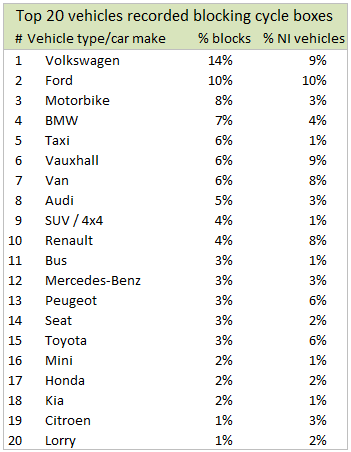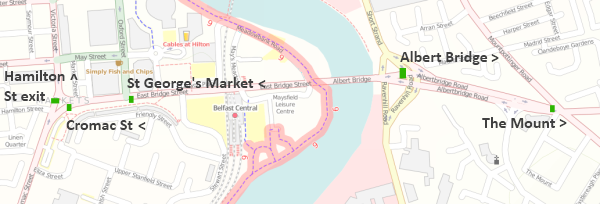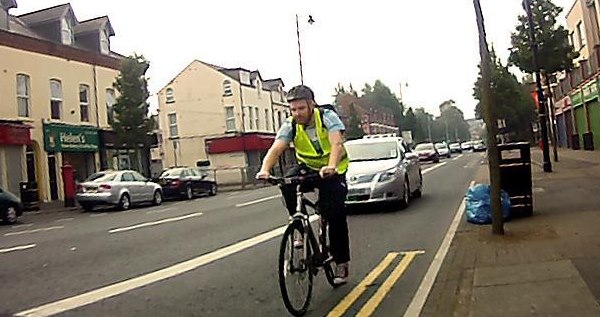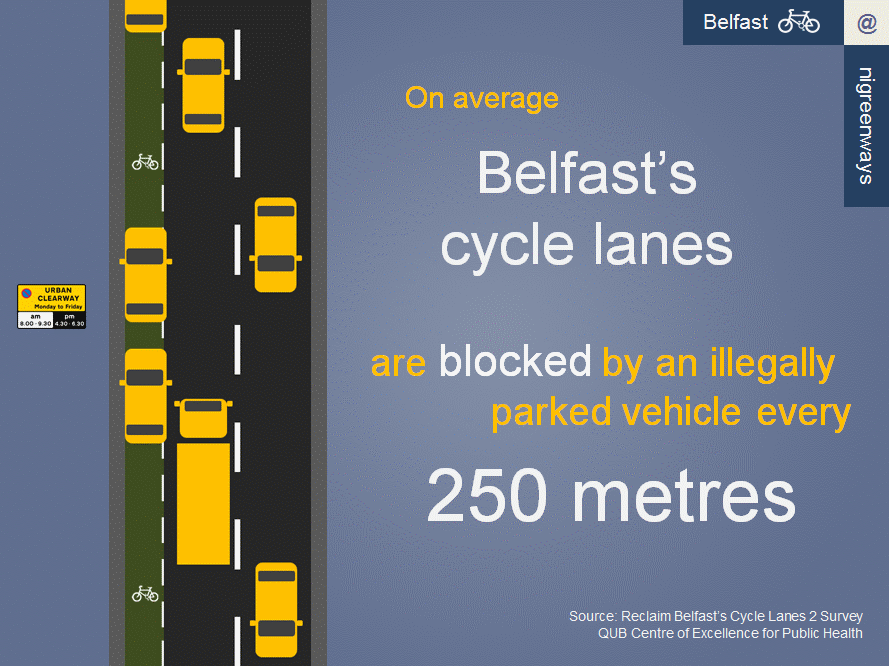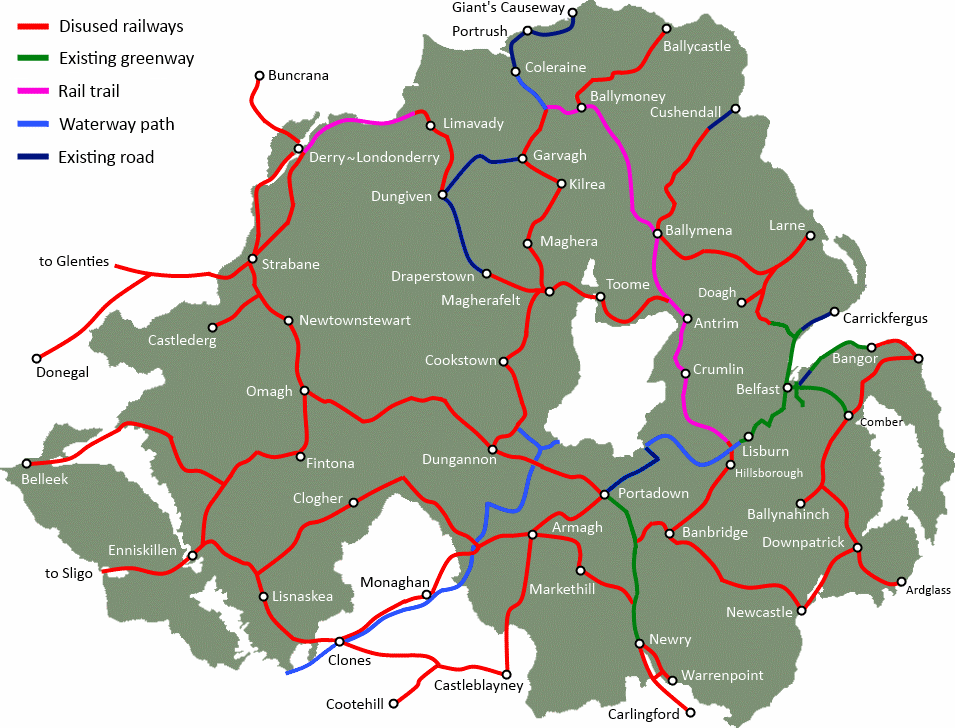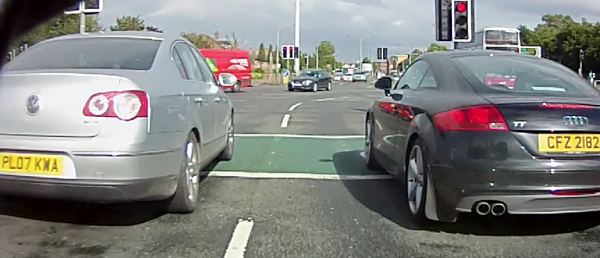
The green cycle box is arguably the most high profile cycling investment in Northern Ireland in the last decade. Roads Service have mercilessly slathered green paint over junctions across the province, in one of many half-hearted attempts to convince people to get cycling on our roads.
I cycle across 6 advanced stop lines (to give them their official title) every day, and I struggle to see the benefit. Their presence encourages some uniquely difficult road manoeuvres, if not actually putting cyclists at greater risk on some parts of our roads. This is bad enough, but when it turns it that vehicles are blocking cycle boxes at 58% of red lights in rush hour it’s time to ask some serious questions.

Gathering evidence
Two years ago I got a mini video camera, which had a handy bike attachment. I started to take it out in 2012 to show some of the dangerous aspects of Belfast cycling. I’ve posted a few videos of dangerous overtaking moves, Maseratis hogging the cycle lane and to demonstrate the problem of illegally parked cars rendering Belfast’s cycle lanes useless.
By forgetting to delete these files as I went, I accidently ended up with a large dataset ready for a personal mini survey of cycling around Belfast!
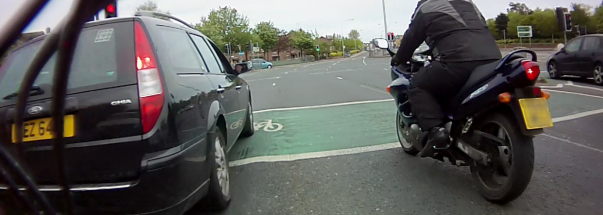
My main commuting journey involves 3 cycle boxes in the morning:
- John Long’s Corner (2 lanes)
- St George’s Market at East Bridge Street (3 lanes)
- Cromac Street pedestrian crossing (3 lanes)
and another 3 in the evening:
- Hamilton Street exit Cromac Square (3 lanes)
- Albert Bridge (5 lanes)
- The Mount (3 lanes)
Reviewing footage from September 2012 to February 2013, I collected key data on cycle boxes from 185 mainly morning and evening rush hour journeys, on:
- whether the light was red
- if vehicles were present
- if the cycle box was blocked by another vehicle (partially or completely)
- if the junction was blocked on green
For balance, I also checked for the biggest problem on our roads, red light jumping cyclists.

During these journeys I encountered 625 cycle boxes. Just 370 had a red light, meaning I’m caught at these junctions 59% of the time.
Discarding 44 red lights (12%) where I didn’t reach (nor have sight of) the cycle box leaves a group of 326 occasions where I could judge interactions with other vehicles.
Blocked cycle boxes
138 cycle boxes were empty, but a whopping 188 cycle boxes had at least one blocking vehicle. That’s a blockage 58% of the time. These blocks involved a total of 285 vehicles, or typically 1.5 vehicles on every blocked cycle box. Just over a third of all blockages involved 2 or more vehicles.
What counted as a blockage? A partial block is where a car had rolled over the stop line (car in the picture below), and a complete block was leaving no room for a cyclist to stop in the cycle box (motorcycle in the picture below). Of all the blocked cycle boxes, the split was:
- one or more vehicles partially covering the cycle box – 84
- one or more completely blocking the cycle box – 70
- a mix of both partial and complete blockages – 34

Each junction with a cycle box has different characteristics, but the stand-out junction for blocking is countrybound at The Mount (video below). This is a 3 lane junction with the outside right lane split to turn onto Castlereagh Street. The 2 ‘straight-on’ lanes benefit from cycle lane access all the way to the junction, but it’s useless for turning right.
Of 88 red lights I stopped at, 75 had at least one vehicle blocking the cycle box – the junction suffers from at least one blocking vehicle at 85% of red lights in rush hour. Added to this, cyclists filtering across 2 lanes to reach the split lane find an incredibly dangerous mix of a light which can’t be timed and a tight gap between traffic islands.
[youtube http://www.youtube.com/watch?v=DJui_rxg85Q]
Cycle boxes (on this particular route) are not providing safe space for cyclists. Knowing your odds of getting comfortably and safely into dedicated cycle space is less than 50/50 means they are practically useless.
Not all vehicles sitting on a cycle box have done it intentionally – many drivers will rightly stop on amber rather than try to speed through the junction, and this may mean coming to a safe halt beyond the first stop line. However the sheer levels of blockages recorded indicates more is at work than just being caught out by light phases.
Whether there is a design solution to this, or it’s all down to driver education is up for debate. But there is that pesky question of enforcement..
What are the police doing to tackle cycle box blocking?
It appears not a lot. An FOI request from last year shows that the PSNI do not differentiate between categories of stop lines offences:
“The offence of breaching an advanced stop line is not differentiated from breach of a normal stop line (at a set of traffic lights) in police issued fixed penalties. Therefore there is no way to determine what manner of breach has occurred.”
This is despite a clear difference in the intent of a stop line with a cycle box (to provide safe space for cyclists) and the effect that offences committed here have on road safety. This is a clear failure, and must be addressed by local politicians. If there’s no evidence of enforcement, it’s fair to suggest there is no enforcement.
Red light jumping cyclists
I shared a red light cycle box with 102 other cyclists. There were 33 recorded instances of rule breaking, although 8 of these were directly caused by vehicles blocking the cycle box, forcing cyclists to advance ahead of the second stop line (picture below).

What was the nature of the rule breaking? 20 cyclists positioned themselves slightly ahead of the cycle box (picture below), which gets more dangerous if you continue to edge forward. Pavement cycling was recorded on 4 occasions, but just 1 true ‘red light jumping’ cyclist was recorded, continuing across The Mount junction while the pedestrian crossing lights were green. For the record then (small sample it may be) that’s less than 1% of cyclists observed jumping a red light on these journeys.
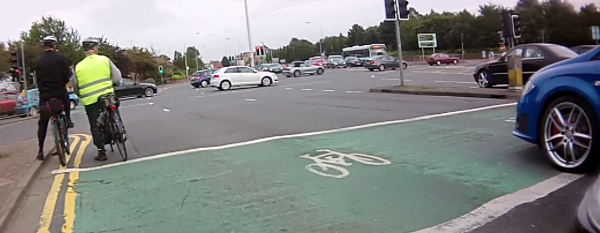
Blocked junctions
Reviewing these junctions led to another clear conclusion, apparently resisted by Roads Service as unnecessary – Cromac Square needs a yellow box junction. Of all the 370 red light cycle box encounters where I could observe the junction ahead, the way was blocked on green 35 times. Not bad, until you realise 27 blockages occurred at the Hamilton Street Exit at Cromac Square. That’s a wildly inefficient junction with 40% blockage rate at rush hour – time to get the paint bucket out Roads Service!
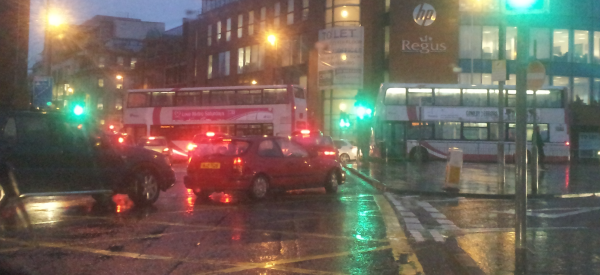
Cycle boxes that are dangerous to reach
The 6 boxes highlighted in this survey have very different characteristics. Just 2 have a cycle lane which protects a separate route for cyclists to reach the box, Hamilton Street Exit and The Mount (for straight-on cycling only). The others leave cyclists to filter through sitting traffic, with little physical space to do so, and perhaps most dangerous from a road safety design perspective, no idea if the light ahead will change before you reach the box.
By far the worst cycle box for this is St George’s Market on East Bridge Street. A with-flow bus and cycle lane (which successfully excludes taxis) leads over the train bridge, followed by a bus gate (not triggered by cyclists) and then a short run to the junction with Oxford Street, notorious for vehicles quickly and sometimes recklessly changing lanes. In sitting traffic, it is virtually impossible to time the lights at the junction. With no separate cycle lane leading up to the cycle box (as with the Hamilton Street Exit), cyclists have a difficult choice – chance filtering down between traffic, or sit back and lose the benefit of the cycle box.
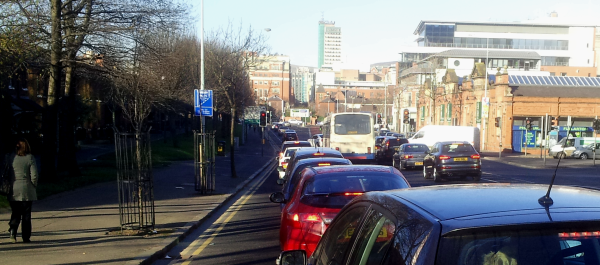
The numbers bear this out, even for an experienced cyclist like me – at 42 red lights I only made it to the cycle box on 22 occasions (52%). Twice I stopped short of the box as it wasn’t worth passing 1 or 2 cars, but 18 times (43%) I was unable to judge the lights and so stayed back in the traffic queue.
Recent census figures showed the concentration of commuter cyclists in South and East Belfast. This means the 2 major cycling gateways to the city are Ormeau Bridge and Albert Bridge (and by extension East Bridge Street) and this is a heavily used junction for cyclists. If nothing else, this mini survey shows attention is needed to provide better and safer access to this cycle box in rush hour.
Finally “the worst drivers are..”
Grumbling motorists cite red light jumping cyclists as a menace; grumbling cyclists cite flashy car drivers or taxis as major dangers. Everyone seems to have a clichéd grudge against someone on the roads.
So let’s not labour the point, but here’s a breakdown of the types of vehicles (out of 240 identified marques) which blocked these cycle boxes, by car make and vehicle category – and what percentage of each are actually on the roads in NI. It’s a small sample with plenty of variables, so it’s just for fun – make of it what you will!
